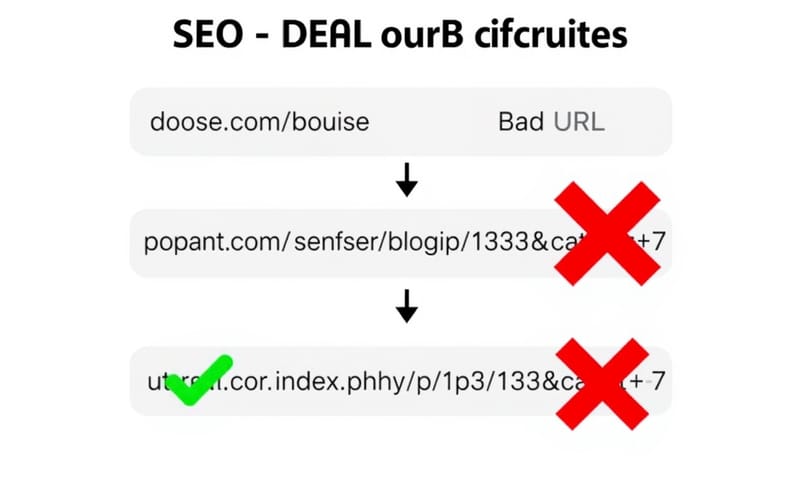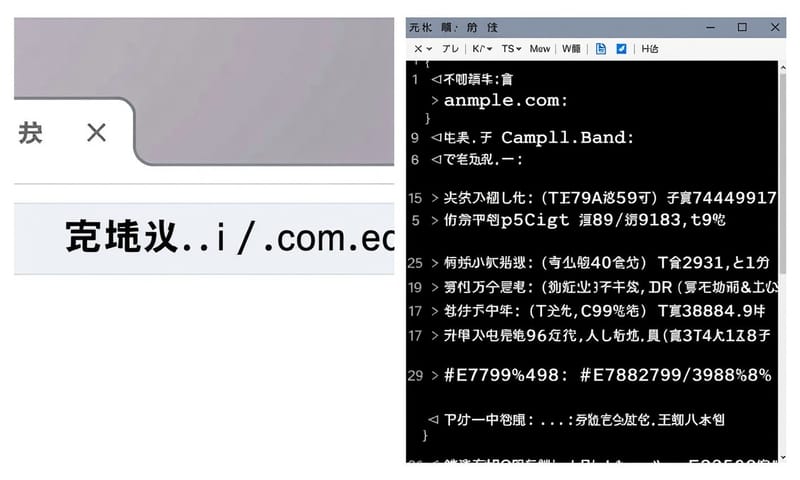好,呃...今天我們來聊一下這個 SEO 友善的 URL 結構要怎麼設計。這個問題其實...嗯...蠻多人問的,但又好像常常被忽略。很多人覺得內容做好就好,但老實說,URL 這個小細節,它...它就像你家的門牌號碼,如果寫得亂七八糟,郵差(也就是 Google)會很困擾,客人(也就是使用者)也會找不到地方。
重點一句話
嗯...如果只能用一句話講完,我會說:「一個好的 URL,就是要讓『人』跟『搜尋引擎』都一眼能看懂這個頁面在幹嘛。」對,就是這麼直白。
我看了幾篇,但有些點好像沒講透
我稍微查了一下,大部分的文章都會提到一些基本功,像是...呃...網址要簡短、要包含關鍵字、要用連字號 `-` 分隔單字等等。這些都沒錯,都是對的。 不過,有幾個點我覺得比較少被深入討論,或是說,大家講得比較保守。
第一個是「中文 URL 的取捨」。很多人會直接說不要用中文,因為分享到外面會變成一長串亂碼。 但這真的是絕對的嗎?在台灣的搜尋情境下,其實有時候中文 URL 反而更直觀,點擊率可能還比較高。這個我們等下會深入聊。
第二個是,大家很強調目錄層級要少,不要超過三層之類的。 但...為什麼?背後的原理是什麼?其實跟 Google 分配給每個網站的「抓取預算 (Crawl Budget)」有關。 簡單說,層級太深的頁面,Google 機器人可能懶得爬進去,覺得不重要,這點很多人就沒有講得很清楚。
還有就是,當 URL 真的非改不可的時候,那個「然後呢?」好像比較少人提。大家都說改了不好,排名會掉,但萬一非改不可,例如公司改品牌名稱、網站整個換架構,那該怎麼辦?「301 轉址」這個步驟超級重要,但常常被一筆帶過。
好,那到底要怎麼做?
好,那我們就來條列一下,到底一個理想的 URL 該怎麼規劃。我自己是把它歸納成五個原則啦。
原則一:保持簡短、有描述性
這應該是最基本也最重要的一點。你的 URL 不是寫給自己看的。像 `.../p=123` 這種無意義的參數,或是 `.../article-2024-10-30-final-v2` 這種,使用者跟 Google 都看不懂。 理想的狀態是,光看網址,使用者大概就能猜到內容,例如 `.../seo-url-structure`,啊,很明顯就是在講 SEO 的 URL 結構。
原則二:包含核心關鍵字
這個也是老生常談了。把頁面的核心關鍵字放進 URL 裡,等於是又一次在跟 Google 強調:「嘿!我這個頁面跟這個關鍵字高度相關喔!」 不過這裡要提醒一下,是「包含」,不是「塞爆」。 像 `.../seo-url-friendly-url-structure-url-design` 這樣硬塞,反而會讓 Google 覺得你在作弊,那就弄巧成拙了。
原則三:用連字號 `-`,不是底線 `_`
這個...算是 Google 官方有明說的潛規則了。對 Google 來說,連字號 `-` 是詞語的分隔符,但底線 `_` 不是,它會把 `seo_url` 看成一個字。 所以,為了讓搜尋引擎能正確斷詞,請務必用連字號,`seo-url` 才是正確的用法。
原則四:反映網站結構(目錄層級)
一個好的 URL 結構,應該要能像麵包屑導覽一樣,清楚地呈現這個頁面在網站裡的什麼位置。 例如,`.../blog/seo/url-structure` 就很清楚,這是在「部落格」分類下的「SEO」子分類裡,一篇關於「URL 結構」的文章。這對使用者和搜尋引擎來說,都能更容易理解你的網站架構。
原則五:統一風格,像是大小寫跟結尾斜線
這點是技術細節,但很重要。對搜尋引擎來說,`.../My-Page` 和 `.../my-page` 是兩個不同的網址。還有 `.../my-page/`(有斜線)跟 `.../my-page`(沒斜線)也可能被當成兩個頁面。 這會造成「重複內容」的問題,分散掉頁面的權重。所以,從一開始就要訂好規則:全部用小寫、並且決定結尾要不要統一加斜線,然後全站都遵守。

來看點實際的例子吧
講了那麼多理論,我們直接看表格比較比較快。我整理了幾個常見情境,比較一下好跟不好的 URL 差別在哪。
| 情境 | 不太理想的 URL (一看就頭痛) | 比較好的 URL (清爽多了) | 我自己是覺得... |
|---|---|---|---|
| 部落格文章 | /blog/post.php?id=88 | /blog/how-to-make-coffee | 用 `id=數字` 這種真的不行,完全看不出內容。改成語意化的英文或中文,使用者一看就懂。 |
| 電商產品頁 | /products/item_A87C_blue_large | /men/shirts/oxford-shirt-blue | 用底線 `_` 是常見錯誤。 還有那個 `A87C` 應該是內部編號吧,給使用者看沒意義。用分類 `/men/shirts/` 清楚多了。 |
| 多語系網站 (以台灣為例) | /en/about-us.html | /tw/about-us (或 /zh-hant/about) | `/en/` 讓人困惑,是給英國人看的還是美國人?用國家碼 `tw` 或語系碼 `zh-hant` 會更精準。這點在做國際 SEO 的時候特別重要。 |
| 含日期的內容 | /news/2024/10/30/event-start | /news/annual-event-2024-recap | 把日期放在 URL 裡,如果未來內容更新了,日期就變得很奇怪,而且很佔空間。 除非是那種有時效性的新聞,不然不太建議。 |

常見的坑,還有一些大家常搞混的
最後來講幾個大家最常卡關或誤解的地方。
迷思一:中文 URL 到底好不好?
這真的是大哉問。反對的人會說,中文 URL 複製貼到 LINE 或臉書,會變成一長串 `%E5%A5%BD%E9%95%B7` 的亂碼,很醜、很佔空間。 這點沒錯。但從另一個角度看,如果你的主要客群都在台灣,搜尋的也都是中文,那像 `.../blog/如何泡咖啡` 這樣的網址,在搜尋結果頁上其實非常醒目、直觀,對點閱率可能是有幫助的。這點,國外的 SEO 文件比較少提,因為他們沒這個困擾。 我的建議是,如果你的網站內容不太需要被大量跨國、跨平台分享,那在部落格文章這類內容頁面,勇敢用中文 URL 是可以考慮的選項。但如果是官網首頁、關於我們這種通用頁面,還是用英文比較保險。
迷思二:動態 URL 是不是就沒救了?
像 `.../search?category=shoes&color=red` 這種帶有 `?` 和 `&` 參數的,就是動態 URL。以前的確對 SEO 比較不友善,因為搜尋引擎很難判讀。但現在 Google 已經聰明很多了,它能理解這些參數。 不過,靜態或「偽靜態」的 URL (`.../shoes/red`) 還是比較理想的,因為對使用者更友善,也更好記。 如果你的網站因為系統限制,只能產生動態 URL,那至少要確保使用 `rel="canonical"` 標籤,告訴 Google 哪一個是「正版」的頁面,避免它把不同參數組合當成重複內容。
迷思三:改了 URL 之後,舊的就放給它爛?
這大概是...最嚴重的錯誤了。很多人花了錢改版網站,URL 全換了,結果舊的網址全部變成 404 (找不到頁面),過去累積的 SEO 分數一夕歸零。正確的做法是,只要有任何一條 URL 變更,就必須設定「301 永久轉址」。 這就像是去郵局辦理地址變更通知,告訴搜尋引擎:「我搬家了,請把舊地址的信(和權重)全部轉到這個新地址來。」不做 301 轉址,你過去所有的努力,可以說幾乎都白費了。

總結來說,URL 優化是一個...嗯...一個前期規劃比後期修改更重要的事情。一開始就想清楚結構,後面會省下非常多麻煩。它雖然不是影響排名的唯一因素,但絕對是構成良好使用者體驗和網站體質的基礎建設。
好,今天大概就講到這裡。換你說說看,你在設計 URL 時,最常卡關的地方是什麼?是關鍵字選擇,還是整個網站的目錄結構規劃?可以在下面留言分享一下你的經驗。



